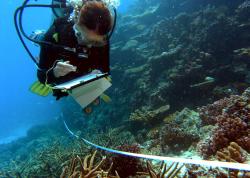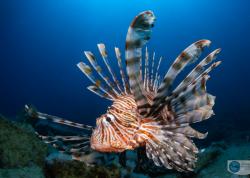Get Involved: Protecting Our Ocean

As divers and underwater photographers, we are more tuned in than most to the current state of the environment. And while much positive progress has been made in recent years, we witness some negative side effects of modern society at the heart of the planet: our oceans. It’s easy to feel helpless and that there is nothing that you can do to help as an individual, but every tiny attempt and gesture does truly make a difference, cumulatively and over time. Here are six easy things you can do as a diver and underwater photographer that can help the big picture.
Practice expert buoyancy control
Most fish have swim bladders that help them to maintain buoyancy. Yours is strapped to your back and called a Buoyancy Control Device. The key word here is “control”. You should (with little effort and minimal weight) be able to hover a foot or less over the reef with precision. It’s important to stay off the reef! There’s no need for sites that are dived frequently to be suffering the ill effects of divers that do not know how to control their buoyancy. Also, always know where your fins and gauges (keep them tucked and secured) are and don’t touch anything living. As photographers we often need to steady ourselves to get the shot. A good rule is to use one or two fingers tips on non-living substrate and no gloves unless absolutely necessary. An ungloved hand is a careful hand.

Don’t stress the wildlife
Sometimes when you want to get the shot you might work with a subject a bit longer than the animal is comfortable with. It’s best to get some shots and then move on. Another opportunity will undoubtedly present itself and you also never know what you’ve truly got on that tiny LED screen anyway. It goes without saying that large pelagics like whale sharks, manta rays and turtles should never be touched or molested in any way. People making pufferfish puff up or manipulating or stressing animals in other cruel ways should be told that their behavior is not appreciated and will not be tolerated.

Buy Smart
Make sure that your dive center, resort, live aboard or hotel is committed to and practicing environmentally friendly business. Check with friends, associates or online bi-partisan reviews to try and get the real story about your next dive vacation. Alternatively, call the owner or manager and ask them about their recycling practices, water use policies, etc.

Know your Subject/Spread the Word/Share your Work
As divers and photographers we know how wonderful the undersea world can be. Many people have no concept of how amazing the ocean is or how essential its health is to our own continued existence. Find out as much as you can about the subject you are photographing: name, habitats and behavior, and when you share your work be sure to include that information for the benefit of all. Share your work freely and to as many sources as possible. If people don’t know anything about these amazing creatures it is very hard to care about them and have an invested interest in the animal’s future.

Make a difference even when you’re not diving
Take the daily steps necessary to have as small a bio-footprint as possible. Use little plastic (it never goes away), limit water use (we can’t make more), try to purchase locally sourced foods whenever possible (your health will thank you for it), take your bike instead of the car whenever possible (your health will thank you for it) and of course, always recycle.

Get involved in Special Projects
Become a Citizen Scientist! You can make a difference, whether doing fish surveys or helping to eradicate Caribbean Lionfish (www.reef.org), helping with coral restoration or beach and harbor clean ups. You could also go into your kid’s school to give a talk and slide show of the many creatures you have “captured,” or let the kids breathe on a regulator. There are many, many ways that you can have a positive impact. Doing your part is just that simple. And if you do break a sweat it will be well worth it.

About the Author
 Jonathan Lavan: The owner/operator of Underpressure Diving & Nature Photography is a citizen scientist and wildlife expert and has been SCUBA Diving for thirty years and taking photographs both above and below the water for about 10. He was pleased to have been made Volunteer of the Year for 2012 by the Reef Environmental Education Foundation. As a SCUBA Diver he has been a photographer, teacher and research associate for many different organizations. Among them: National Geographic, Smithsonian, Scuba Diving Magazine, Natures Best Photography Magazine, Encyclopedia of Life/Earth, Florida Museum Of Natural History, OnEarth, Fishwise, Fishbase, Monterey Bay Aquarium, Defenders of Wildlife, Discover The Depths, REEF and Shedd Aquarium. He is a staunch environmentalist and educator of young people. Jonathan is committed to making a difference on this planet through his images and his message of good will to all creatures. www.underpressurephotog.com.
Jonathan Lavan: The owner/operator of Underpressure Diving & Nature Photography is a citizen scientist and wildlife expert and has been SCUBA Diving for thirty years and taking photographs both above and below the water for about 10. He was pleased to have been made Volunteer of the Year for 2012 by the Reef Environmental Education Foundation. As a SCUBA Diver he has been a photographer, teacher and research associate for many different organizations. Among them: National Geographic, Smithsonian, Scuba Diving Magazine, Natures Best Photography Magazine, Encyclopedia of Life/Earth, Florida Museum Of Natural History, OnEarth, Fishwise, Fishbase, Monterey Bay Aquarium, Defenders of Wildlife, Discover The Depths, REEF and Shedd Aquarium. He is a staunch environmentalist and educator of young people. Jonathan is committed to making a difference on this planet through his images and his message of good will to all creatures. www.underpressurephotog.com.
Further Reading
-
10 Underwater Creature Facts We Bet You Don't Know
-
The Ultimate Guide to Sea Turtle Photography
-
Celebrating California's Underwater Parks
Where to Buy
Please support the Underwater Photography Guide by purchasing your underwater photography gear through our sister site, Bluewater Photo & Video. Click, or call them at (310) 633-5052 for expert advice!
RECOMMENDED ARTICLES
SUPPORT THE UNDERWATER PHOTOGRAPHY GUIDE:
The Best Service & Prices on u/w Photo Gear
 Visit Bluewater Photo & Video for all your underwater photography and video gear. Click, or call the team at (310) 633-5052 for expert advice!
Visit Bluewater Photo & Video for all your underwater photography and video gear. Click, or call the team at (310) 633-5052 for expert advice!
The Best Pricing, Service & Expert Advice to Book your Dive Trips
 Bluewater Travel is your full-service scuba travel agency. Let our expert advisers plan and book your next dive vacation. Run by divers, for divers.
Bluewater Travel is your full-service scuba travel agency. Let our expert advisers plan and book your next dive vacation. Run by divers, for divers.






























